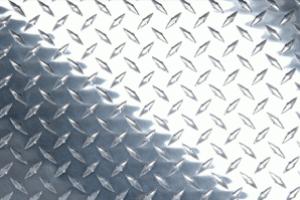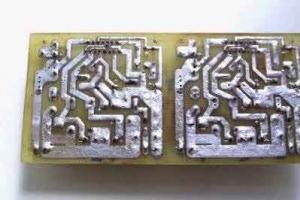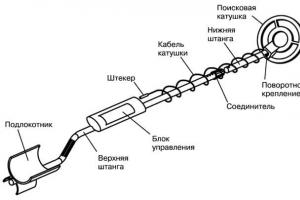Today, there are many different ideas on the Internet that allow you to make a metal detector with your own hands at home. Some of them require certain skills in working with electrical appliances, soldering and understanding of simple electrical circuits, while some do not require any knowledge in these areas to create. However, there are many non-working, fake methods floating around the Internet, captivating with their simplicity and accessibility. It is very easy for an inexperienced person to fall for the bait of deceivers - to spend time and effort on making a device that is obviously not working and lose all interest in it. But don’t be discouraged, then readers of “” will be provided with an interesting and really working scheme for creating a homemade metal detector!
Idea No. 1 – Discs in action!
Surely you have already seen or heard that you can make the simplest metal detector yourself using a CD and DVD disc, as shown in the photo. The scheme is quite simple and does not require any professional tools or skills.
This instruction is the most popular due to the availability of the necessary components and the ease of assembly; you just need to connect a couple of wires and the crown together and the device is ready. At the same time, the characteristics of this device are attributed to be quite good - it finds a coin at a distance of 25-30 cm, which is quite enough for searching for coins and treasures. However, unfortunately, this instruction is fake.
The fact is that the metal detector itself is a rather complex device; its operation is based on several physical phenomena at once. Therefore, a calculator and a pair of disks cannot even remotely replicate its operating principle, no matter what the creators of such instructions claim, who sometimes write that they even find treasures with the help of such homemade products.

It is very easy to understand that you are being deceived even without knowledge of the laws of physics. The wires from the headphones that need to be attached to the disk do not actually contact it in any way, since the copper is under a layer of varnish insulation, which must be removed by firing and labor-intensive cleaning of carbon deposits; of course, none of the authors of the instructions does this in their devices . Consequently, the headphones are simply not connected to any circuit, and there can be no talk of any work, much less metal detecting.
 A real metal detector operates on the basis of an induction balance; its design must have at least one coil of copper wire. When a metal object enters the field of the coil, its characteristics or the received signal, depending on the design, change. These changes are recorded and amplified by the circuit, and also displayed in a form understandable to humans, usually by means of sound signals.
A real metal detector operates on the basis of an induction balance; its design must have at least one coil of copper wire. When a metal object enters the field of the coil, its characteristics or the received signal, depending on the design, change. These changes are recorded and amplified by the circuit, and also displayed in a form understandable to humans, usually by means of sound signals.

Video instructions for assembling a metal detector from disks
Idea No. 2 – Metal detector according to the “Pirate” scheme
This is a scheme that has been tested by many DIYers and allows you to achieve good results. It contains two microcircuits, so you will have to make a small printed circuit board or assemble the device on a breadboard. But don’t be alarmed, anyone can make this option if they put in the necessary effort. Below is an electronic circuit diagram of the device and a printed circuit board for it.

 The coil is made of enameled copper wire with a diameter of 0.5 mm. Winding should be done on a frame with a diameter of 200-260 mm, the number of turns from 21 to 25. For reliability, it is better to install the coil in a protective plastic casing, which can then be attached to a handle made of PVC pipes.
The coil is made of enameled copper wire with a diameter of 0.5 mm. Winding should be done on a frame with a diameter of 200-260 mm, the number of turns from 21 to 25. For reliability, it is better to install the coil in a protective plastic casing, which can then be attached to a handle made of PVC pipes.

After assembling the metal detector, it must be checked. The procedure for use is as follows: turn on the device away from metal objects for about 30 seconds so that its operation is more stable, then rotate the variable resistor knob for coarse and fine adjustment, you need to achieve rare clicks. When metal enters the action area, you will hear a characteristic sound.
Below is a detailed video assembly instruction, which clearly shows all the stages of creating a homemade metal detector.
A device that allows you to search for metal objects located in a neutral environment, such as soil, due to their conductivity is called a metal detector (metal detector). This device allows you to find metal objects in various environments, including in the human body.
Largely thanks to the development of microelectronics, metal detectors, which are produced by many enterprises around the world, are highly reliable and have small overall and weight characteristics.
Not so long ago, such devices could most often be seen among sappers, but now they are used by rescuers, treasure hunters, and utility workers when searching for pipes, cables, etc. Moreover, many “treasure hunters” use metal detectors, which they assemble with their own hands .
Design and principle of operation of the device
Metal detectors on the market operate on different principles. Many believe that they use the principle of pulse echo or radar. Their difference from locators lies in the fact that the transmitted and received signals act constantly and simultaneously; in addition, they operate at the same frequencies.
Devices operating on the “receive-transmit” principle record the signal reflected (re-emitted) from a metal object. This signal appears due to the exposure of a metal object to an alternating magnetic field generated by the metal detector coils. That is, the design of devices of this type provides for the presence of two coils, the first is transmitting, the second is receiving.
Devices of this class have the following advantages:
- simplicity of design;
- Great potential for detecting metallic materials.
At the same time, metal detectors of this class have certain disadvantages:
- metal detectors can be sensitive to the composition of the soil in which they search for metal objects.
- technological difficulties in the production of the product.
In other words, devices of this type must be configured with your own hands before work.
Other devices are sometimes called beat metal detectors. This name comes from the distant past, more precisely from the times when superheterodyne receivers were widely used. Beating is a phenomenon that becomes noticeable when two signals with similar frequencies and equal amplitudes are summed. The beat consists of pulsating the amplitude of the summed signal.
The signal pulsation frequency is equal to the difference in the frequencies of the summed signals. By passing such a signal through a rectifier, it is also called a detector, and the so-called difference frequency is isolated.
This scheme has been used for a long time, but nowadays it is not used. They were replaced by synchronous detectors, but the term remained in use.
A beat metal detector works using the following principle - it registers the difference in frequencies from two generator coils. One frequency is stable, the second contains an inductor.
The device is configured with your own hands so that the generated frequencies match or at least are close. As soon as metal enters the action zone, the set parameters change and the frequency changes. The frequency difference can be recorded in a variety of ways, from headphones to digital methods.
Devices of this class are characterized by a simple sensor design and low sensitivity to the mineral composition of the soil.
But besides this, when operating them, it is necessary to take into account the fact that they have high energy consumption.
Typical design
The metal detector includes the following components:
- The coil is a box-type structure that houses the signal receiver and transmitter. Most often, the coil has an elliptical shape and polymers are used for its manufacture. A wire is connected to it connecting it to the control unit. This wire transmits the signal from the receiver to the control unit. The transmitter generates a signal when metal is detected, which is transmitted to the receiver. The coil is installed on the lower rod.
- The metal part on which the reel is fixed and its angle of inclination is adjusted is called the lower rod. Thanks to this solution, a more thorough examination of the surface occurs. There are models in which the lower part can adjust the height of the metal detector and provides a telescopic connection to the rod, which is called the middle one.
- The middle rod is the unit located between the lower and upper rods. Devices are attached to it that allow you to adjust the size of the device. On the market you can find models that consist of two rods.
- The top rod usually has a curved appearance. It resembles the letter S. This shape is considered optimal for attaching it to the hand. An armrest, a control unit and a handle are installed on it. The armrest and handle are made of polymer materials.
- The metal detector control unit is necessary to process the data received from the coil. After the signal is converted, it is sent to headphones or other display devices. In addition, the control unit is designed to regulate the operating mode of the device. The wire from the coil is connected using a quick release device.
All devices included in the metal detector are waterproof.
It is this relative simplicity of design that allows you to make metal detectors with your own hands.
Types of metal detectors
There is a wide range of metal detectors on the market, used in many areas. Below is a list that shows some of the varieties of these devices:
Most modern metal detectors can find metal objects at a depth of up to 2.5 m; special deep products can detect a product at a depth of up to 6 meters.
Operating frequency
The second parameter is the operating frequency. The thing is that low frequencies allow the metal detector to see to a fairly large depth, but they are not able to see small details. High frequencies allow you to notice small objects, but do not allow you to view the ground to great depths.
The simplest (budget) models operate at one frequency; models that fall into the middle price range use 2 or more frequencies. There are models that use 28 frequencies when searching.
Modern metal detectors are equipped with a function such as metal discrimination. It allows you to distinguish the type of material located at depth. In this case, when ferrous metal is detected, one sound will sound in the search engine’s headphones, and when non-ferrous metal is detected, another sound will sound.
Such devices are classified as pulse-balanced. They use frequencies from 8 to 15 kHz in their work. Batteries of 9 - 12 V are used as a source.
Devices of this class are capable of detecting a gold object at a depth of several tens of centimeters, and ferrous metal products at a depth of about 1 meter or more.
But, of course, these parameters depend on the device model.
How to assemble a homemade metal detector with your own hands
There are many models of devices on the market for detecting metal in the ground, walls, etc. Despite its external complexity, making a metal detector with your own hands is not that difficult and almost anyone can do it. As noted above, any metal detector consists of the following key components - a coil, a decoder and a power supply signaling device.
To assemble such a metal detector with your own hands, you need the following set of elements:
- controller;
- resonator;
- capacitors of various types, including film ones;
- resistors;
- sound emitter;
- Voltage regulator.
Do-it-yourself simple metal detector
The metal detector circuit is not complicated, and you can find it either on the vast world wide web or in specialized literature. Above is a list of radio elements that are useful for assembling a metal detector with your own hands at home. You can assemble a simple metal detector with your own hands using a soldering iron or other available method. The main thing is that the parts should not touch the body of the device. To ensure the operation of the assembled metal detector, power supplies of 9 - 12 volts are used.
To wind the coil, use a wire with a cross-sectional diameter within 0.3 mm; of course, this will depend on the chosen circuit. By the way, the wound coil must be protected from exposure to extraneous radiation. To do this, shield it with your own hands using ordinary food foil.
To flash the controller firmware, special programs are used, which can also be found on the Internet.
Metal detector without chips
If a novice “treasure hunter” has no desire to get involved with microcircuits, there are circuits without them.
There are simpler circuits based on the use of traditional transistors. Such a device can find metal at a depth of several tens of centimeters.
Deep metal detectors are used to search for metals at great depths. But it is worth noting that they are not cheap and therefore it is quite possible to assemble it yourself. But before you start making it, you need to understand how a typical circuit works.
The circuit of a deep metal detector is not the simplest and there are several options for its implementation. Before assembling it, you need to prepare the following set of parts and elements:
- capacitors of various types - film, ceramic, etc.;
- resistors of different values;
- semiconductors - transistors and diodes.
Nominal parameters and quantity depend on the selected circuit diagram of the device. To assemble the above elements, you will need a soldering iron, a set of tools (screwdriver, pliers, wire cutters, etc.), and material for making the board.
The process of assembling a deep metal detector looks something like this. First, a control unit is assembled, the basis of which is a printed circuit board. It is made from textolite. Then the assembly diagram is transferred directly to the surface of the finished board. After the drawing is transferred, the board must be etched. To do this, use a solution that includes hydrogen peroxide, salt, and electrolyte.
After the board is etched, it is necessary to make holes in it to install the circuit components. After tinning the board. The most important stage is coming. Do-it-yourself installation and soldering of parts onto a prepared board.
To wind the coil with your own hands, use PEV brand wire with a diameter of 0.5 mm. The number of turns and the diameter of the coil depend on the selected circuit of the deep metal detector.
A little about smartphones
There is an opinion that it is quite possible to make a metal detector from a smartphone. This is wrong! Yes, there are applications that install under Android OS.
But in fact, after installing such an application, he will actually be able to find metal objects, but only pre-magnetized ones. It will not be able to search for, much less discriminate against, metals.
Devices capable of detecting metal objects in weakly conducting environments are called metal detectors, or metal detectors. They can be used to search for ferrous and non-ferrous metals. A homemade metal detector for coins is capable of detecting small items at a distance of 10 to 50 cm, and larger metals from 0.5 to 3 m.
The use of metal detectors has been known since ancient times, and a large increase in their production occurred at the end of the 60s. Thanks to progress and a variety of schemes, any novice radio amateur can make a metal detector with his own hands, without resorting to extensive knowledge in electronics. The main advantage of homemade metal detectors is low costs.
Let's assemble a simple metal detector that operates on two frequency generators - a beat metal detector. At the same frequency, the generators are synchronized, but when one of the metal coils enters the field, the frequency in one of the generators changes. As a result, the circuit reproduces the sound of the difference in frequencies of two generators in the dynamics.
Tools and materials for the device
To make a homemade metal detector, you need to divide the process into three stages - creating a design, implementing a circuit, and assembling it into a single whole. We will describe an approximate list of tools and materials that may be needed for these purposes. Further on in the article, we will explain in more detail: what a metal detector for gold can be assembled from, and what kind of material is best to use. Let's start by preparing a tool for beginning diggers. To work you will need:
- Cutters for working with wires and parts;
- Knife;
- Saw for plastic. In extreme cases, you can use a knife or a regular saw;
- Soldering iron;
- Screwdriver Set.
Necessary materials:
- Insulating tape;
- Soldering kit. You can just use rosin and solder;
- Glue;
- Parts and board for the circuit;
- Wire for coil;
- A piece of plastic and a plastic pipe;
- Fasteners.
Preparing parts
Detailed instructions on selecting and searching for parts are described here.
First, you need to decide on the material and fastening of the components of the metal detector and find the necessary components.
As a barbell, you can use a crutch with an armrest, a fishing rod, a pipe made of cross-linked polyethylene or polyvinyl chloride (Fig. 2).

The coils and circuitry will be placed underneath on a stand attached to the rod. So it is important to consider the stiffness of the bar and its material. It is better to give preference to dielectrics, i.e. non-conducting electric current - plastic, wood, etc. It is necessary to make a handle to make it comfortable to hold the metal detector being manufactured. In the case of a crutch, it is not needed, but in another case, you can attach either a bicycle handlebar or another homemade structure.
The stand for the circuit and coils can be made from ordinary plastic. It is easy to trim and weighs little. You will need one bottom sheet, since access to the coils is required to adjust the device. To reduce vibration of the circuit with coils, it is advisable to choose stronger plastic.
After preparing the rod and stand, you need to connect them. You can use fasteners, but do not forget that for the circuit to work properly, you should not bring metal products closer than 30 cm. Therefore, we use good glue, for example, liquid nails. You can use other materials - it all depends on your abilities in plumbing and carpentry.
The wire for the coils must be insulated. Suitable enameled copper wire with a diameter of 0.5 - 0.7 mm grade PEV or PEL. The wire length is about 100 meters. An oil-based varnish is suitable for fixing parts.
The parts can be mounted using a hinged method on PCB or cardboard. For beginning radio amateurs, in specialized stores you can buy processed textolite from the factory or material with holes for parts. You can also make a board yourself from solid unprocessed PCB. To do this, you need to mark the location of the contacts of the radio components on the diagram, then separate the sections of the textolite with a knife and tin the pads and tracks (Fig. 3). We cut off the excess part of the PCB with a plastic saw.

To assemble a working metal detector, radio components can be found at home in old radio equipment, but it is advisable to purchase them in a store. Identical parts must be completely identical and preferably from the same batch. Table 1 provides a list of necessary parts and comments, the implementation of which will lead you to assembling a high-quality metal detector.
After finding all the necessary parts, you can easily assemble the metal detector at home.

Assembling the device

Having considered the list of necessary materials and parts, we will answer in detail how to assemble a metal detector from them with your own hands.
To wind the coils, we use any round object with a diameter of 20–25 cm. The number of turns is 30. We bring out one end of the wire and wind it 10 turns, after which, without breaking it, we bring out the second end. We continue winding another 20 turns and bring out the third end. We make the wire leads with a margin of 10 to 20 cm. Remove the resulting winding from the object and wrap it tightly with electrical tape, leaving three wire leads (Fig. 5).

We perform the second coil in a similar way. For the greatest success, we make the coils as identically as possible, with a mirror image.
Let's start assembling the radio components. We arrange the parts on the board and carry out soldering according to the diagram in Figure 4. When using cardboard or material with holes, we connect the parts with insulated wires of any cross-section. When using prepared PCB, we perform soldering to the finished tracks. The circuit can be placed in a wooden or plastic box.
Solder the coil leads according to the diagram. We solder and bring out two wires with a connector for the battery.

We prepare a stand for the circuit and coils. We select the dimensions taking into account that the distance between the coils must be at least 10 cm, since the circuit and the attached rod must fit between them.
To properly secure the coils, temporarily attach the headphones to the circuit and insert the battery. By slightly moving the coils, we achieve silence in the headphones with single clicks or the highest possible, barely audible sound. We try to bring metal to one of the coils, if we hear significant changes, this indicates the functionality of the metal detector. We fix the coils and the board in this position. If possible, it is better to glue them immediately and then cover them with oil varnish.
For headphones, we make two holes in the rod - bottom and top. Using wire cutters, electrical tape and a soldering iron, we extend the headphone wire to the required length - from the circuit to the human ear area. You need to take growth into account right away. We stretch the wire inside the rod and solder it to the circuit.
We cut off the excess stand and attach the bar to it in a way convenient for you.

Adjustment
The most accurate setting is the absence of clicks in the headphones, and the presence of a barely audible high-frequency squeak.
Adjustment is carried out in three ways:
- We bring the metal one by one to the coils. On the coil where the noise has stopped, we bring the last turn inside the coil ring.
- You can use small pieces of aluminum. We bring them to the coils and achieve silence or single clicks. Secure with glue.
- We attach a tube to the coil and insert a ferrite rod through it. Having achieved the desired result, we fix the rod in this position. Watch the video below, which demonstrates how to make a homemade regulator for tuning using this method.
With good hearing and experience, you can use the manufactured metal detector as a simple metal detector with discrimination, that is, with recognition of types of metal.
Modernization
If you have figured out how to make the simplest metal detector with your own hands, you can proceed with a small modernization without microcircuits in Figure 9. The list of parts is collected in Table 2.


The new circuit adds an RC circuit consisting of a resistor and a capacitor. It will allow you to achieve increased sensitivity.
Variable resistors have been added to adjust the circuit without touching the coils. This will seal the sensitive unit of the metal detector in a durable box that protects it from shock.
Instead of headphones, you can use a speaker with a capacitor to increase the volume slightly.
In this scheme, the coils are placed one on top of the other, as shown in Figure 10. Before fixing the coils, we adjust them by moving them.

When turned on, we set the variable resistors to the same position and by rotating we achieve precise adjustment. After that, all that remains is to take a metal detector and go in search of nuggets or metals. Tested in practice - if you search on any Russian beach, you can find gold and silver.
Finding artifacts underground is a fairly popular activity. For some, this is a profession, others are simply interested in archaeology. There are numerous groups of treasure hunters: both romantics and pragmatic treasure hunters. All these people are united by one passion: searching for metal objects hidden at various depths.
Just because you have an accurate map showing where the treasure is buried, or plans for fighting during the war, this does not guarantee success. You can shovel tons of soil, and the desired item will calmly lie a couple of meters from the active search site.
To search for gold and less valuable metals, you will need a metal detector that you can make yourself.
Important information: The use of such devices is not prohibited by law. However, there are penalties for the consequences of such a search regarding excavations, as well as the recovery of discovered objects.
We won’t go into details; that’s the topic of another article. Simply put: if you find a gold ring on the beach, or a handful of Soviet coins in the forest, there will be no problems associated with the use of electronic search tools.
But for recovered bronze spoons that are 100 years old or older, you can get a real sentence or a large fine.
Nevertheless, devices for searching for metal objects in the depths of the earth are freely sold, and those who want to save money can make a metal detector with their own hands at home.
How the device works
Unlike ground detectors, which work using waves of different frequencies or ultrasound, a metal detector (either factory-made or home-made) works with inductance.

The coil emits an electromagnetic field, which is then analyzed by the receiver. If any object that conducts electric current or has ferromagnetic properties is in the coverage area, the field format is distorted. More precisely, under the influence of the active field of the coil, the object forms its own. This event is recorded by the receiver, and an alert is generated: the instrument needle moves, a tone sounds, and indicator lights light up.
Knowing the operating method, you can calculate the electrical circuit and create a powerful metal detector with your own hands. The complexity of the design depends only on the availability of the element base and your desire. Let's look at several popular options for assembling a homemade metal detector:
The so-called "butterfly"
This nickname was received due to the characteristic shape of the platform on which the inductors are located.

The arrangement of the elements is related to the operating principle. The circuit is made in the form of two generators operating at the same frequency. When identical coils are connected to them, an induction balance is created. As soon as a foreign object with electrical conductivity gets into the electromagnetic field, the balance of the field is destroyed.
Generators are implemented on NE555 chips. The illustration shows a typical diagram of such a device.

The coil for the metal detector (there are two of them, in the diagram: L1 and L2) is made by hand from wire with a cross section of 0.5–0.7 mm². The ideal option is a transformer winding copper core in varnish insulation (removed from any unnecessary transformer). The characteristics do not have to be maintained with pinpoint precision, under one condition: the coils must be identical.
Approximate parameters: diameter 190 mm, each coil has exactly 30 turns. The assembled product must be monolithic. To do this, the turns are grabbed with a mounting thread and filled with transformer varnish. If this is not done, vibration of the turns will throw the circuit off balance.
Electrical diagram
There are two manufacturing options:
- given the small number of elements, you can assemble it on a breadboard by connecting the legs of the parts using conductors;
- For accuracy and reliability, it is better to etch the board according to the proposed drawing.

Any “snot-based” soldering can fail in the field, and you will be offended for wasting your time.
Just like a transistor metal detector, the NE555 device needs fine tuning before use. The diagram shows three variable resistors:
- R1 is designed to adjust the frequency of the generator and achieve that same balance;
- R2 coarsely adjusts sensitivity;
- Using resistor R3, you can set the sensitivity with an accuracy of 1 cm.
Information: This scheme cannot discriminate against metals. The seeker only makes it clear that the object exists. And by the tone of the signal (based on your experience) you can determine the approximate volume and depth of the deposit.
The power supply is quite universal: 9–12 volts. You can select a battery from an uninterruptible power supply, or assemble a power supply from AAA batteries. A good option is 18650 batteries (they are also used for vaping).
Butterfly setting
The principle of operation is described above, so let’s just look at the technology. We set all resistors to the middle position, and ensure that the synchronization of the generators is disrupted. To do this, we fold the coils in a figure eight and move them relative to each other until the squeaking turns into crackling. This is a synchronization failure.

We fix the rings and rotate the resistor R1 until a steady crackling sound appears at even intervals.
By bringing metal objects to the place where the coils overlap (this is the search point), achieve a steady squeak. The sensitivity is adjusted by resistor R2.
All that remains is adjustment with resistor R3, which is used rather to correct the voltage drop in the power source.
Mechanical part
A do-it-yourself metal detector rod is made from a lightweight plastic pipe or wood. The use of aluminum is undesirable as it will interfere with operation. The circuit and controls can be hidden in a sealed housing (for example, a junction box for wiring).

The butterfly finder is ready to go.
Pirate
Another popular pulse model for beginner treasure hunters is the “Pirate” metal detector. It is also easy to make with your own hands, detailed instructions in two versions:

It is advisable to bring the power supply closer to 12 volts, since the quality of operation depends on the voltage. Printed circuit boards have already been tested, both options are shown in the illustration.

The coil (in this case one) is made from the same 0.5 mm transformer wire. The optimal diameter is 20 mm, the number of turns is 25. Since we are making the “Pirate” metal detector with our own hands, the external design fades into the background. Any materials that you were ready to throw away will do.

It is better to make the handle detachable for ease of transportation. We remember that the use of metals is unacceptable.

Sensitivity is adjusted by two variable resistors in real time while searching. No fine tuning of the generator is required.
And if you manage to properly seal the case, you can start searching for “treasures” in the beach surf, and even at the bottom of the reservoir.

It is more difficult to make an underwater metal detector with your own hands, but it will give you an undeniable advantage over your competitors.
Improved performance
You can make a deep metal detector with your own hands from a ready-made “Pirate” without additional costs. There are two ways to do this:
- Increasing the diameter of the inductor. At the same time, downward permeability increases significantly, but sensitivity to small objects decreases.
- Reducing the number of coil turns while simultaneously adjusting the circuit. To do this, you will have to sacrifice one coil for experiments. We remove (and cut off) turn after turn until we see that the sensitivity begins to decrease. We remember the number of turns at maximum parameters, and make a new coil for this circuit. Then we change the resistor R7 to a variable one, with similar power parameters. After conducting several experiments with sensitivity, we fix the resistance and change the variable to a constant resistor.
The Pirate metal detector can be assembled using the popular Arduino controller.

It is more convenient to use such a device, but there will still be no metal discrimination.
Having figured out how to make a metal detector with your own hands for amateur tasks, we will briefly examine several serious models.
DIY metal detector Clone PI W
In essence, this is a cheaper version of the professional finder Clone PI-AVR, only instead of an LCD display, a line of LEDs is used. This is not as convenient, but still allows you to control the depth of artifacts.
The best option for the price is the CD4066 chip and ATmega8 microcontroller.

Of course, there is also a printed circuit board layout for this solution, only the control buttons are placed on a separate panel.

Programming ATmega8 is a topic for a separate article; if you have worked with such controllers, no difficulties will arise.
The powerful Clone PI W metal detector, made by yourself, allows you to find metal no more than a meter deep, although without discrimination.
Seeker "Chance"
A similar circuit on the ATmega8 controller is called “Chance”. The principle of operation is similar, only the possibility of screening out (partial discrimination) of ferrous metals has become possible.

A printed circuit board design has also been worked out, which can be successfully replaced with a classic “breadboard” for Arduino

DIY Terminator 3
If you need a homemade metal detector with metal discrimination, pay attention to this model. The scheme is quite complicated, but your efforts pay off with the coins you find, which may turn out to be gold.

The peculiarity of the “Terminator” is the separation of the receiving and transmitting coils. A 200 mm ring is made to emit the signal. 30 turns of wire are laid for it, then it is cut, as a result we get 2 half-coils with a total capacity of 60 turns (see diagram).
The receiving coil is located inside, 48 turns with a diameter of 100 mm.
The adjustment is made using an oscilloscope; after achieving optimal amplitude results, the windings are fixed in the housing by pouring epoxy resin.

Then an experimental hands-on adjustment of the discrimination switch is performed. For this, real objects made of various metals are used, and their type is marked on the mode switch (after verification).
Radio amateurs are working on an improved version of Terminator 4, but there is no practical copy yet.
Simple metal detectors from ready-made electrical appliances

Bottom line
Regardless of the complexity of the design, making a homemade metal detector will require a lot of time and effort from you. Therefore, out of curiosity, such devices are not made. But for professional use, this is an excellent alternative to factory copies.
Video on the topic
As a child, did you want to have a device that could be used to find metal objects and even treasure? Most children want to have such a unit. Fortunately, it exists. This is a conventional metal detector that allows you to detect various metals under a layer of soil and in other places. The principle is that it finds a material that differs in its magnetic or electrical properties from its environment. It is noteworthy that you can find not only metal objects and not only in the ground.
The metal detector is used by geologists, security services, the military, criminologists and construction workers. This is a very useful thing in the household. Is it possible to make a metal detector with your own hands? Yes, and this article will help you with this.
How does a metal detector work and what does it consist of?
In order to make such a device at home with your own hands, you need to understand the principle of its operation. How is it able to detect metal and signal it? It's all about electromagnetic induction. Metal detectors have their own circuit, consisting of:
- Transmitter of electromagnetic wave oscillations.
- Receiver.
- A special signal transmitting coil.
- Coil that receives the signal.
- Display devices.
- Discriminator (useful signal selection circuit).

Some operating units can be combined schematically and structurally. For example, both the receiver and the transmitter can operate on the same coil. Part of the receiver will immediately emit a positive signal and so on.
Now let’s take a closer look at the operating principle of the metal detector. Thanks to the coil, an EMF (electromagnetic field) of a certain structure begins to be created in the medium. In the case when an object that conducts electricity is within the range of this field, Foucault or eddy currents appear in it. They create the object’s own EMF. Now the original structure of the coil begins to become distorted. And when an object located in the ground does not conduct electricity, but has ferromagnetic properties, then due to shielding, the structure of the coil is also distorted. In both the first and second cases, the metal detector picks up the electromagnetic field from the object and converts it into a signal (acoustic or optical). You hear a certain sound and can see the signal on the screen.

Note! In general, for a metal detector to work, it is not necessary that the body conduct current; the ground does not. It is important that the magnetic and electrical properties of bodies differ.
This is how a metal detector system works. The principle is simple and effective. Now, let's take a closer look at how to make a metal detector with your own hands. The first thing you need is to prepare all the tools and materials.
Metal detector components
So, if you want to make a device, then you cannot do without special devices. This is still an electronic device that needs to be assembled from various components. What will be required? The set is as follows:

You can see other components in the diagram below.
Additionally, you will need a plastic box to mount the electronic circuit. Also prepare a plastic pipe to create a rod with a coil attached to it. Now you can get to work.
Assembling a metal detector with your own hands: creating a printed circuit board
The most difficult stage of work is the electronics. Everything here is subtle and complex. Therefore, it is rational to start with creating a working printed circuit board. There are only a few options for different boards. It all depends on the radioelements used to create it. There are boards operating on the NE555 chip and on transistors. Below you can see what these boards look like.
We assemble a metal detector with our own hands: installing electronic elements on the board
Further work will also not be easy. All electronic elements of the metal detector will have to be soldered and installed as shown in the diagram. In the photo you can see the capacitors. They are film-like and have high thermal stability. Due to them, the operation of the metal detector will be much more stable. This indicator is very useful, especially during the autumn period of using the device. After all, it gets quite cool outside then.
All that remains is to do the soldering. We will not describe the process itself, since the soldering technology should be known to everyone. To clearly understand how to perform all the work on the electronic part of the metal detector, we suggest that you additionally familiarize yourself with this video:
Assembling a metal detector with your own hands: power supply
In order for the device to receive current, you need to provide a power source of 9-12 V. It is worth noting that the metal detector consumes electricity quite voraciously. This is not surprising, since the device is quite powerful. If you think that one “Krona” (battery) will be enough, then this is not so. He won't work for long. You will need two or even three batteries connected in parallel. Alternatively, use one powerful battery. It will be cheaper since it can take a long time to discharge and charge.

Assembling a metal detector with your own hands: coil
Since we are making a pulsed metal detector, careful and precise assembly of the coil is not required. The normal diameter of the coil will be 19-20 cm. To do this, you will have to wind 25 turns. Once you have made the coil, wrap the top well with insulating tape. To increase the depth of detection of objects by the coil, wind the diameter of the send about 26-27 cm. In this case, you need to reduce the number of turns to 21-23. In this case, a wire Ø 0.5 mm is used.
Once you have wound the coil, you will need to mount it on the hard body of the metal detector. It is important that there is no metal on the body. Think and look for any case that will fit in size. The housing will perform a protective function. The coil will be protected from impacts on the ground during searches.
To make a tap from the coil, solder two wires Ø 0.5-0.75 mm to it. It is recommended to use 2 wires twisted together.

Assembling a metal detector with your own hands: setting up the device
When assembling a metal detector according to the diagram, you do not need to configure it. It already has maximum sensitivity. To fine-tune the metal detector, adjust the variable resistor R13 by twisting it slightly. Do this until you hear occasional clicks. In the case when this is achieved at the extreme position of the resistor, change the rating of the R12 device. Such a variable resistor should configure the metal detector to operate optimally in the middle position.

There is a special oscilloscope that allows you to measure the gate frequency of resistor T2. The pulse length should be 130-150 μs, and the optimal operating frequency should be 120-150 Hz.
To start the metal detector search process, you need to turn it on and wait about 20 seconds. Then it will stabilize. Now twist resistor R13 to adjust it. That's all, you can start your search using a simple metal detector.
Let's sum it up
Such detailed instructions will help you learn how to make a metal detector yourself. It is simple but fully capable of finding metal objects. More complex models of metal detectors require more effort and time.








